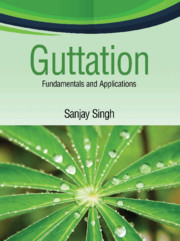Book contents
- Frontmatter
- Dedication
- Contents
- List of Figures
- List of Tables
- Foreword
- Preface
- Acknowledgments
- List of Abbreviations
- 1 Phenomenon of Guttation and Its Machinery
- 2 Principles of Guttation and Its Quantification
- 3 Mechanism of Guttation
- 4 Regulation of Guttation
- 5 Chemistry of Guttation
- 6 Plant Microbiology and Phytopathology of Guttation
- 7 Significance of Guttation in Soil–Plant–Animal–Environment Systems
- 8 Significance of Guttation, Associated Structures, and Root Secretion in the Production of Pharmaceuticals and Other Commercial Products
- 9 General Conclusions and Future Perspectives
- Appendices
- Bibliography
- Index
1 - Phenomenon of Guttation and Its Machinery
Published online by Cambridge University Press: 12 May 2020
- Frontmatter
- Dedication
- Contents
- List of Figures
- List of Tables
- Foreword
- Preface
- Acknowledgments
- List of Abbreviations
- 1 Phenomenon of Guttation and Its Machinery
- 2 Principles of Guttation and Its Quantification
- 3 Mechanism of Guttation
- 4 Regulation of Guttation
- 5 Chemistry of Guttation
- 6 Plant Microbiology and Phytopathology of Guttation
- 7 Significance of Guttation in Soil–Plant–Animal–Environment Systems
- 8 Significance of Guttation, Associated Structures, and Root Secretion in the Production of Pharmaceuticals and Other Commercial Products
- 9 General Conclusions and Future Perspectives
- Appendices
- Bibliography
- Index
Summary
Introduction
Secretions in plants, animals, and humans constitute natural and fundamental metabolic processes vital for their life (Fahn 2000; Squires 2010; Vivanco and Baluska 2012; Wilson 2009). In plants, guttation is one of the conspicuous secretions, which has been known for about three-and-a-half centuries (precisely 348 years). Abraham Munting of Holland (now the Netherlands) was the first to discover this phenomenon way back in 1672, though the word ‘guttation’ was not in existence then. Moreover, the subject was not in the mainstream of research until about two to three decades ago, though the secretory tissues are present in most vascular plant species. The substances present in the secretions of hydathodes, secretory glands, and nectaries are mostly in unmodified or only slightly modified forms, and they are supplied directly or indirectly through vascular systems. Apart from these secreting organs, some other secreting tissues exist that secrete, for example, polysaccharides, proteins, and lipoids, and these substances are produced by them in their own cells. Secretory tissues usually contain numerous mitochondria; however, the distribution of other cell organelles varies in accordance with the materials they secrete. The side wall of the lowest stalk cell in the most glandular trichomes is completely cutinized, which prevents the flow of secreted materials back into the plant body. In this chapter, the occurrence and taxonomic distribution of guttation and morphological, anatomical, and ultrastructural aspects of hydathodes, that is, the mouths of guttation, have been described in some detail based on the current available information and discovery (Singh 2013, 2014a,b, 2016a,b).
Definition of guttation
The term ‘guttation’ (coined by Burgerstein in 1887) is derived from a Latin word gutta, which means ‘drop’. It is also referred to as the secondary compound exudated from certain trees, that is, trans-1,4 polyisoprene, which has a lower molecular weight than that of natural rubber. The phenomenon of guttation and its process have been known for 350 years (Ivanoff 1963); however, its significance in plant physiology was not known (Stocking 1956a). It is basically a biophysical and physiological occurrence in which fluid is expelled out through the leaves. Guttation has many implications and applications in agriculture, in balancing the ecosystem, as well as in pharmaceutical and industrial products (Singh et al. 2008, 2009a; Singh and Singh 2013; Singh 2014a,b, 2016a,b).
- Type
- Chapter
- Information
- GuttationFundamentals and Applications, pp. 1 - 18Publisher: Cambridge University PressPrint publication year: 2020
- 2
- Cited by

